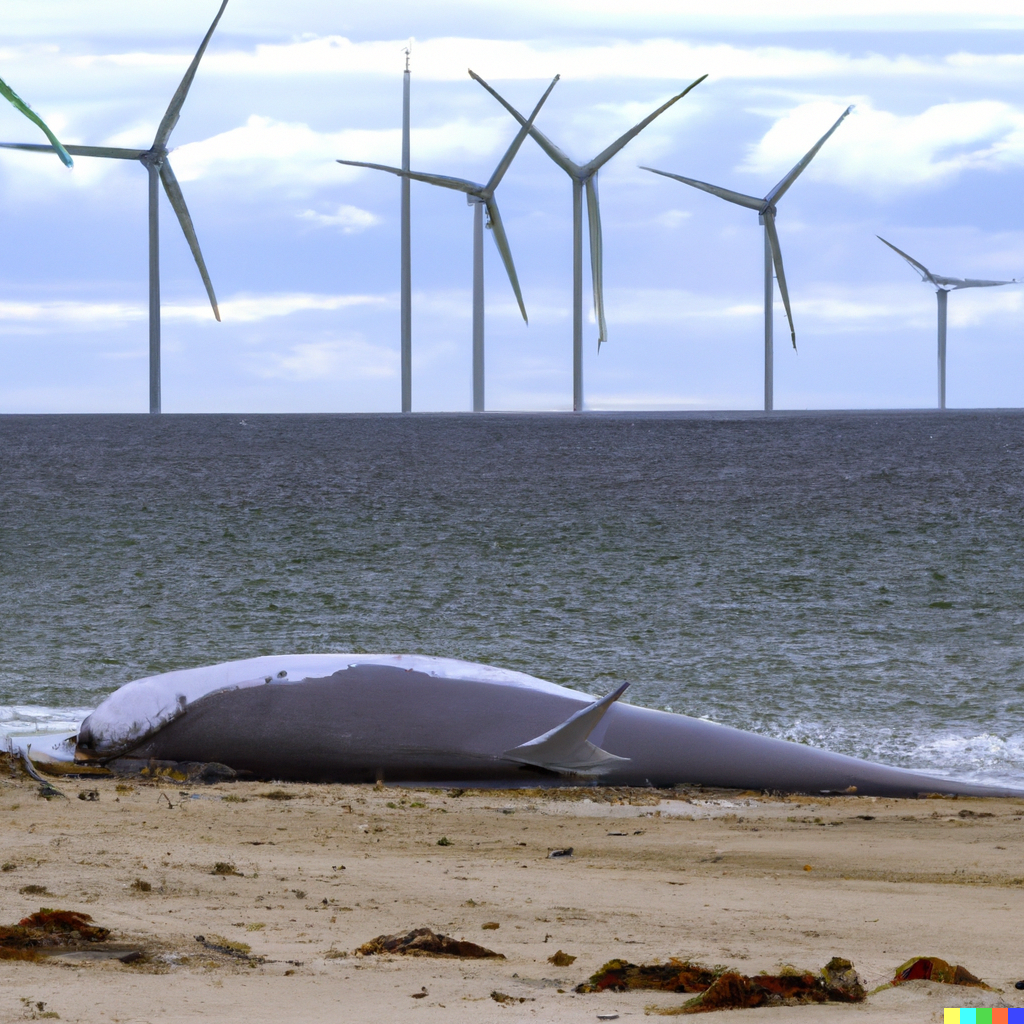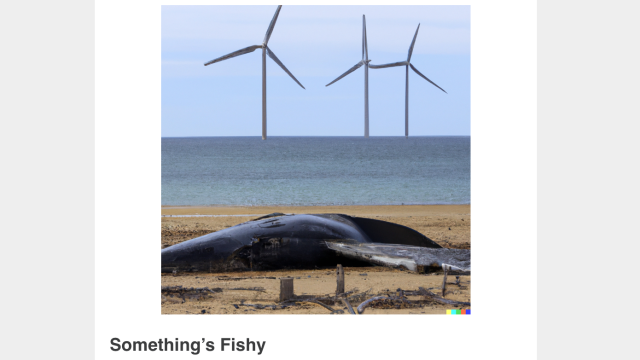Readers of the daily email newsletter of one of the country’s leading right-wing, fossil fuel-funded think tanks were treated to a bizarre sight this week: an AI-generated image of a dead whale washed ashore on a beach in front of wind turbines, above a fearmongering story about offshore wind. Unfortunately, what is isolated to one newsletter today could spread around the right-wing ecosystem tomorrow.
I cover climate and read breaking news about renewable energy every day; if there were a real photo of a dead whale in front of a wind farm like this, chances are I would have seen it. Still, the image gave me a jump when I opened the email from the Texas Public Policy Foundation. For a moment, I wondered if I’d somehow missed a huge story about a dead humpback that had washed ashore in front of a wind farm.
The story under the image is old hat for this particular newsletter. The Texas Public Policy Foundation, or TPPF, is one of the leaders in the national right-wing push against renewable energy — specifically against offshore wind. Despite its location in Texas, the group has lent its sizable financial muscle to anti-offshore wind efforts on the East Coast, joining a lawsuit against a project filed by local fishermen and creating an entire movie about the evils of wind energy.
The image is at least recognisably an AI generation: there’s the tell-tale uncanny valley nature of the pattern of the debris of the beach, and the blades of the wind turbines are, well, bendy, in a way that you certainly don’t see in real life. The biggest giveaway is the DALL-E generator watermark at the lower right hand corner of the image. When I plugged in various search terms, like “beached dead humpback whale in front of offshore wind turbines” into the DALL-E generator, I got images that looked a lot like what was at the top of my newsletter. (Some of mine were much better, not gonna lie.)

Still, the image is, at first glance, realistic enough to make me do a double-take, and there’s no label on the image marking it as not a real photograph. Readers of the newsletter who aren’t familiar with how AI images look or who are just skimming could certainly be forgiven for thinking that this is real evidence of dead wildlife near a wind farm.
I reached out to TPPF to confirm that the image was AI-generated and to ask whether the writers considered labelling it as such. I’ll update this story if I hear back.
I personally find it hilarious that a foundation that got a sick $US17 ($24) million in donations in 2020, according to IRS records, and has enough cash to make a whole movie about how scary wind turbines are would turn to a shoddy free AI job to run at the top of its newsletter. But a real photo that looks like this — a dead whale posed ominously under some wind turbines — would be worth its weight in gold to the right.
Since December, many humpback whale carcasses have washed ashore on the coast of New York and New Jersey, in what’s known as an “unusual mortality event” for the marine mammals. Scientists have emphasised that these events are not unprecedented, and the Bureau of Ocean Management has said that there’s no link between offshore wind development and these whale deaths. But anti-renewable energy activists have seized on the deaths to erroneously claim that surveying for upcoming offshore wind projects is causing the deaths. (Tucker Carlson is currently running a series called “The Biden Whale Extinction.”)
Climate deniers have historically used doctored, misleading, or out-of-context photos or charts to portray bad information, including a long-running magazine cover hoax that an advisor famously passed off to Donald Trump as real during his administration. Wind turbines are especially prone to this treatment. Back in 2021, when Texas’s power grid was experiencing a massive failure, a picture of a turbine being de-iced in Sweden in 2014 began circulating on right-wing Twitter as state leaders were falsely blaming renewable energy for the blackouts; Rep. Lauren Boebert later tweeted about the image.
Why should we care about some random right-wing newsletter slapping up an AI-generated image? For starters, TPPF is a big player in the right-wing think tank space. There’s no denying that the group is incredibly influential: some of the dominant current climate and energy narratives among the right, including the war on ESG, originated with or were perpetuated by TPPF and its fossil fuel donors. TPPF even got its own profile in the New York Times late last year.
What’s isolated to denier newsletters today may become viral images tomorrow. Ketan Joshi, an energy analyst who has been tracking energy misinformation online, told me that he expects to see deniers turn increasingly to AI to help spread bad intel.
“There is already a massive resurgence of old-school climate denier content, alongside early signs of a worrying trend of that having an impact on public views,” Joshi told me. “AI tools that are designed to create convincing-sounding lies with no references or factual basis, along with image tools that can create vaguely convincing images in seconds without risking any copyright issues, are a boon to deniers.”
Free AI image generation can only go so far, at least for now. Still, the proliferation and perfection of tools like DALL-E and ChatGPT can only help bad information spread.
“One thing that’s worth noting is that [AI] probably can’t fabricate charts or data, which is a big part of denier content,” Joshi said. “I think this won’t be used to create ‘fake news’ type things; i.e., they won’t easily able to fabricate, say, a picture of a bird colliding with a turbine. But it just pushes the cost of creating disinformation one big notch downwards.”
